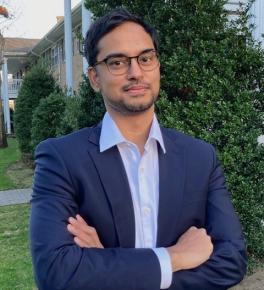
Search for the Chiral Magnetic Effect with isobar collisions at the Relativistic Heavy Ion Collider
Dr. Prithwish Tribedy
Brookhaven National Laboratory
Location: 1080 Physics Research Building, Smith Seminar Room
Faculty Host: Michael Lisa

Abstract: Relativistic heavy ion collisions (HICs) at the modern accelerators like the Relativistic Heavy Ion Collider and the Large Hadron Collider provide a unique testing ground for the Quantum Chromodynamics (QCD) at high energies. The early stages of such collisions generate highest densities allowed by QCD and eventually lead to the formation of a liquid-like quark-gluon matter (QGP) that filled the microsecond-old universe. Interestingly, the early stages of HICs also generate the strongest known electromagnetic fields (10^18 Gauss) in the universe. The quantum fluctuations in the early stages of such collisions amidst such strong fields can lead to violation of local P and CP symmetries of strong interaction. As a consequence of such extreme conditions one expects to observe novel phenomena such as the Chiral Magnetic Effect (CME). Previous measurements of the CME remain inconclusive because of large background contributions. In order to better control the influence of signal and backgrounds, the STAR collaboration has recently performed a blind analysis on a large data sample of approximately 3.8 billion isobar Ru+Ru and Zr+Zr collisions at the center of mass energy of 200 GeV at the Relativistic Heavy Ion Collider. In this colloquium I will briefly introduce the history of the CME search in HICs and discuss the findings from the isobar blind analysis.
Related Links:
[1] Collisons of 'isobars' test effect of magnetic field, searching for signs for a broken symmetry.
[2] M. Abdallah et al. (STAR Collaboration), (2021), arXiv:2109.00131 [nucl-ex], https://arxiv.org/abs/2109.00131
Speaker's Brief Bio:
Prithwish Tribedy is an Associate Physicist at the Department of Physics at the Brookhaven National Laboratory. His research interests lie in the field of relativistic heavy ion collisions with a specific focus on the study of the QCD matter at the high-gluon density, initial state physics and the Chiral Magnetic Effect. Prithwish is currently an active member of the STAR experiment at the Relativistic Heavy Ion Collider. He received his Ph.D. degree from the Homi Bhabha National Institute, India in 2015, he then worked as a postdoc (2015-19) at the Brookhaven National Laboratory before becoming an Assistant Physicist in 2019. He was promoted to the position of an Associate Physicist in Sept 2021.
Participate on Zoom.
